2010-2019 Contents
2010-2037 - At some point during this period, a devastating earthquake hits the west coast of the USA
2010 - Scientists create synthetic life | Iran is on the brink of revolution | China becomes the largest energy consumer in the world | Localised renewable energy is becoming affordable | Apple debuts the iPad | Augmented Reality is entering the mainstream | OLED screens are becoming widespread | Macular degeneration is curable | Speech-to-speech translation is common in mobile phones | Major breakthrough in robotics | Increased automation in retail environments | The Space Shuttle fleet is retired
2011 - Humanitarian crisis in Somalia | Internet has a greater reach than television | Multi-touch surface computing is available to the mass market | The first open petaflop supercomputer comes online | Batteries that charge in seconds | 22 nanometre chips are in mass production | USB 3.0 is available | Consumer-level robotics are booming | Completion of the ISS | World's first commercial spaceport | China's Three Gorges Dam is fully operational
2012 - Economic growth remains sluggish in many markets | London hosts the Olympic Games |
Brain-computer interfaces allowing the paralysed to walk again | A cure for baldness | World's first 1-GW offshore wind farm | Mars Science Laboratory explores the Red Planet | Barack Obama is re-elected
2013 - Iran carries out its first nuclear test | 3D technologies are widespread | India launches its second lunar exploration mission
2014 - James Webb telescope is launched | Personalised DNA sequencing for less than $100 | Internet "lifecasting" enters the mainstream | 16nm chips are in mass production | Robotic pack mules are entering military service | MAVEN probe arrives at Mars | Most phone calls are made via the Internet now | Brazil hosts the FIFA World Cup
2015-2019 - Virtual Reality makes a comeback
2015 - Worldwide PC use reaches 2bn | Nanotech water filters are spreading to many developing countries | The first climate change refugees | 3D printing enters the consumer market | New Horizons probe arrives at Pluto | Dawn probe arrives at Ceres | Voyager I enters the heliopause
2016 - The US military withdraws from Afghanistan | US vehicles are becoming more fuel-efficient | Holographic versatile disc (HVD) replaces Blu-Ray | Bio-cameras matching human eye resolution |
Rio de Janeiro hosts the Olympic Games
2017 - Total solar eclipse in the USA | Crossrail opens in London | Electronic paper is widespread | Portable medical lasers that seal wounds | Teleportation of simple molecules
2018 - The ITER experimental fusion reactor is switched on | The European Extremely Large Telescope is operational | Ubiquitous internet nodes connect appliances, vehicles, etc. | Robot insect spies are in military use | Consumer devices with 100 Gbit/s transfer speeds | Anti-fat drug is available | The new World Trade Center is complete
2019 - Computers break the exaflop barrier | Bionic eyes are commercially available | Automated freight transport | The Aral Sea disappears from the map | Global oil demand exceeds 100 million barrels per day
2010-2037
At some point during this period, a devastating earthquake hits the west coast of the United States*
Experts had been warning for years that it wasn't a matter of "if" - but "when".
The earthquake is centred on the Los Angeles basin, and is of sufficient magnitude to cause over $100 billion worth of damage. Many thousands of buildings are destroyed and there is widespread damage to roads, infrastructure, energy and water supplies. Hundreds of people are killed, while thousands more are injured.
This disaster comes as California is already going through a fiscal crisis - plunging the state into bankruptcy.
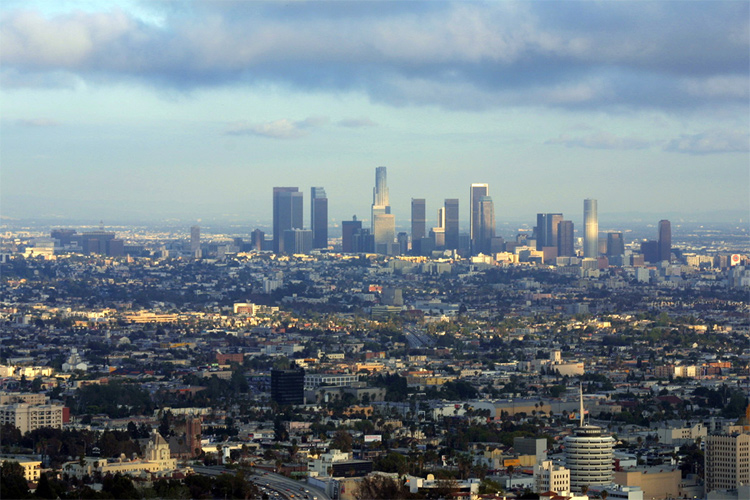
GNU Free Documentation License / Credit: Thomas Pintaric
2010
Scientists create artificial life
In a giant leap for biotechnology, a team of scientists led by DNA pioneer Dr Craig Venter have successfully created the first artificial lifeform. Mycoplasma laboratorium is an entirely new species of bacterium, with a man-made set of genetic code - originating on a computer - and placed on a synthetic chromosome inside an empty cell. Using its new "software", the cell can generate proteins and produce new cells.
This breakthrough raises profound questions about the essence of life, with concerns about the technology falling into the wrong hands, being used to make biological weapons, or by scientists to "play God". Instead of having a genetic relative that it evolved from, the parent of this cell is a computer.
However, the potential benefits of synthetic genomics will arguably outweigh the dangers. The ability to rewrite the software of life will revolutionise the field of biology - leading to radical new vaccines and medicines, clean water technology, advanced biofuels and much more.*
Iran is on the brink of revolution
For years, the Iranian people have suffered hardship and repression at the hands of a corrupt and tyrannical regime.
In June 2009, the disputed results of the presidential election were followed by mass protests around the country. These were bigger in scale than the unrest seen during the 1979 revolution.
Tensions boiled over, with government forces taking an increasingly fierce stance. This only intensified the violence, leading to full-scale riots and the shooting dead of demonstrators in the streets. Many hundreds were arrested. Footage of the protests - taken by phones and spread via the Internet - revealed to the world just how volatile the situation was becoming.*
President Ahmadinejad and his clerics attempted to blame the West, in order to stir up patriotic feeling among Iranian citizens, but this failed to have the desired effect.
In 2010, further protests combined with an even more ruthless crackdown by the government is pushing the nation towards a second revolution.*

Source: Lapost
China becomes the largest energy consumer in the world
China's development as an industrialised country means that this soaring energy demand will continue for some time to come.* Its economic growth has led to a massive increase in the production of cars, trucks and other vehicles, not to mention buildings and infrastructure (which includes almost one new power plant every week).
Localised renewable energy is becoming affordable
In many countries, the number of homes with solar power is growing exponentially - thanks to plummeting costs and increasing government incentives. This is particularly true in the USA, where the cost of a typical five-kilowatt rooftop system has dropped from $22,000 in 2007 to just $13,000 by the end of 2010, making it affordable to the middle classes.*
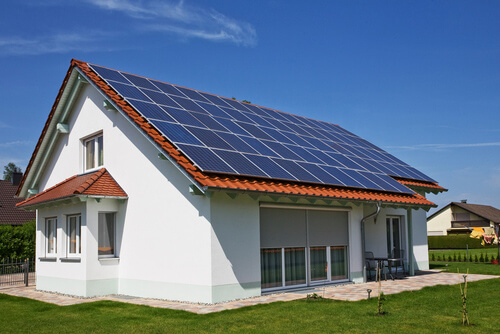
Credit: OxfordSquare
Apple debuts the iPad
The iPad is Apple's first tablet computer - a device category between a smartphone and laptop computer. Similar in functionality to a larger and more powerful iPhone or iPod touch, it runs a modified version of the same operating system (iPhone OS). Its included applications are also redesigned to take advantage of the larger screen with added functionality similar to their Mac OS X counterparts.
The iPad has a 9.7-inch (25 cm) LED backlit multi-touch display with a pixel resolution of 1024x768, 16 to 64 gigabytes (GB) of flash memory, a 1-gigahertz (GHz) Apple A4 processor, Bluetooth 2.1, and a dock connector to sync with iTunes and connect wired accessories.
Augmented Reality (AR) is entering the mainstream
A growing number of cellphones, cameras and other digital devices now feature augmented reality. This technology displays 3D virtual elements on a real-world camera view. GPS units in combination with inertial references can map a user's precise location, then relay graphics from the web (or a web-based application such as Google Earth) and superimpose them on-screen.
This concept has already been used in military training (to display imaginary aircraft and vehicles for example), but is now spreading to mainstream uses - such as travel, outdoor pursuits, communication, gaming and entertainment. Other applications include architecture and interior design (to show virtual objects in a room, for example, or to view buildings before they are constructed).
In the coming years, this technology will be available in sunglasses.
The market for mobile AR services is expected to reach $732 million by 2014, with revenues derived from a combination of paid-for app downloads, subscription based services and advertising.
OLED screens are becoming mainstream
Organic, light-emitting diodes (OLEDs) are being utilised in a wide variety of devices now. They use considerably less power than traditional LEDs and LCDs whilst allowing brighter, sharper, thinner displays.
They also eliminate the need for back lights. Sunlight that would normally "wash out" a display has no effect - the screens appear the same even in broad daylight, or when tilted at an angle.
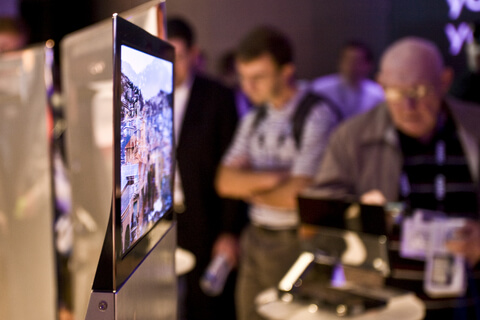
© Syrist | Dreamstime.com
Macular degeneration is curable
Macular degeneration - the leading cause of blindness in people aged 65 and older - can now be treated with a miniature "telescope" implanted in the eye.* Consisting of two lenses within a small glass tube, this works like a telephoto zoom lens. It combines with the cornea to project a magnified image of whatever the wearer is looking at over a large part of the retina. Only the central portion of the sufferer's vision is damaged by the disease, so magnifying the image on the eye allows the retinal cells outside the macula to detect light, refocus it, and redirect the information to the brain.
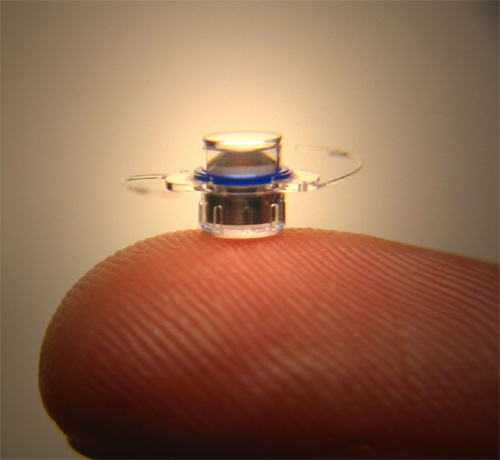
Credit: VisionCare
Speech-to-speech translation is common in mobile phones
Large-vocabulary, continuous, speaker-independent speech recognition is now widespread on cellphones. It has become a popular (and free) iPhone app, as well as being available on Symbian phones and on the Nexus One, using Google's voice translation server.
Major breakthrough in robotics
Robotic manipulation of non-rigid objects - where the configuration is unknown beforehand - is now possible. A robot developed at the University of California is capable of analysing towels "on the fly", rather than being given a fixed set of movements. It can analyse different shapes, colours and materials using a pair of high-resolution cameras, then fold and arrange them into neat piles.*
Increased automation in retail environments
Checkout operators of many large stores and retail chains are increasingly being replaced with automated systems, in order to save costs and improve efficiency. The customer simply scans the items themselves, and is prompted via on-screen instructions and audio to insert their method of payment.
The vast majority of stores continue to use human staff, of course - but this decade marks the beginning of a trend that will lead to major changes in retail environments.
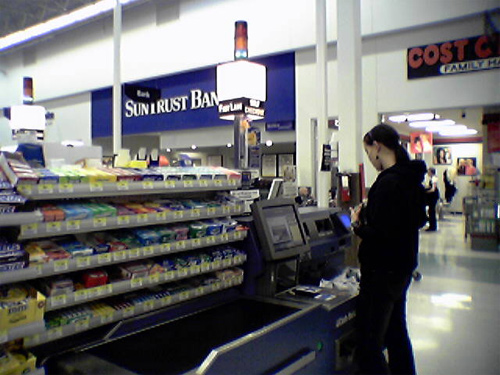
Creative Commons Attribution ShareAlike 2.5 / Credit: Ben Schumin
The Space Shuttle fleet is retired
This year sees the last of the Space Shuttle missions to the International Space Station, and the subsequent retirement of the fleet. Two private companies - SpaceX and Orbital Sciences Corporation - will take over the remaining work, using cheaper disposable rockets. These will provide cargo delivery flights to the ISS up to 2016.
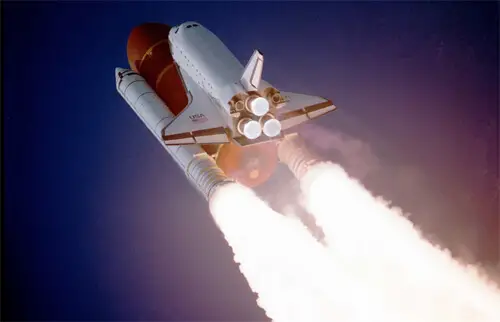
Humanitarian crisis in Somalia
Somalia is facing its worse humanitarian crisis in decades. The country is now ranked as the most dangerous place in the world. Its southern half is de facto controlled by groups openly claiming allegiance to Al Qaeda. These terrorists are using the country as a haven from which to plan attacks on the West.
Somalia's government is now on the brink of collapse, having lost control of Mogadishu. The country is rapidly descending towards anarchy, threatening the food security of its people.
Piracy is also a major problem off the nation's coast, disrupting many trade and supply routes.
The situation has deteriorated so much that large-scale intervention by the US military is being discussed.
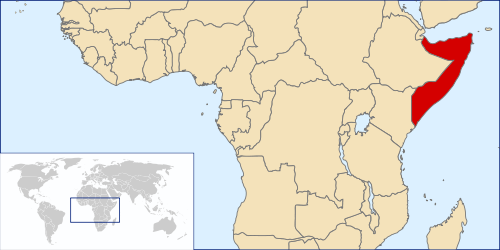
Credit: Rei-Artur
The Internet has a greater reach than television
In the previous decade, a rapid and irreversible shift towards web-based news outlets saw the decline of traditional print-based media. This growth has accelerated further - such that even television is now having less reach than the Internet when it comes to news reporting.
Television and the Internet are in fact now converging together as one. Improving bandwidth and the continued growth of mobile technologies are driving much of this change.
Multi-touch surface computing is available to the mass market
These devices have been available in leisure and entertainment venues for a couple of years already - but are now cheap enough to be affordable to the mass market. The use of multi-touch technology is increasing substantially during this time. For example, sales of touch screen phones will rise from 200,000 in 2006 to over 21 million in 2012.
The first open petaflop supercomputer comes online
"Blue Waters", the first open scientific research supercomputer to sustain one petaflop performance (one quadrillion calculations per second), comes online at Iowa State.* While the military supercomputer "Roadrunner" achieved this speed in 2008, its use was restricted to limited climate change problems before being placed in a classified environment to study the aging functionality of nuclear weapon stockpiles.* "Blue Waters", on the other hand, is open to university access and runs a range of science and engineering applications.
Batteries that charge in seconds
A new manufacturing process for lithium-ion batteries has led to smaller, lighter batteries capable of being charged within seconds. Mobile phones, laptops and other digital devices benefit tremendously from this. Electric cars, too, can take advantage of this greatly improved technology, which now offers far greater convenience. Uptake of green vehicles therefore begins to increase significantly from this point onwards. Solar and wind power generation efficiency is also boosted, as the batteries can be used to store surplus energy.
22 nanometer chips are in mass production
The successor to 32nm, this latest generation of chips continue the trend of Moore's Law, each containing more than 2.9 billion transistors. They will, in turn, be succeeded by 16nm chips - close to the limits of miniaturisation for integrated circuits.
USB 3.0 available
Digital devices using this type of connection have a transfer speed of nearly 5 Gbit/s.
This compares with 480 Mbit/s for USB 2.0 and 1.5 Mbit/s for USB 1.0.
Consumer-level robotics are booming
Thanks to falling costs, this decade sees the beginning of robots entering mainstream society. From 2008 to 2011, sales of professional and personal service robots more than double - from 5.5 million to over 11.5 million.*
Initially popular in Japan, Korea and the Far East, they are now spreading to Western homes too. Some robots clean carpets or mow the lawn; others help busy professionals entertain children or pets; other machines feed and bathe the elderly and incapacitated.
Completion of the International Space Station
This is by far the largest man-made structure ever put into orbit - measuring 110m wide, with a mass of 345,000 kg and a living volume of 1000 cubic metres. The primary fields of research on board the station include human research, space medicine, life sciences, physical sciences, astronomy and meteorology. It will remain in operation until the early 2020s.

World's first commercial spaceport
A new chapter in space exploration begins with the opening of Spaceport America - the world's first purpose-built commercial spaceport. This offers sub-orbital spaceflights to the paying public.
Costing almost $225 million, the facility is built on 27 square miles (70 km2) of state-owned desert near Upham, an uninhabited part of New Mexico.
Among the various companies involved is Richard Branson's Virgin Galactic. Travelling at over 2,600mph (4,200km/h), the spacecraft carry up to six passengers at a time, to a height of approximately 68 miles (110km), using a single hybrid rocket motor. When maximum altitude is reached, the engines are switched off, and the passengers can experience up to six minutes of zero-G whilst looking down on the Earth.
The ships use a feathered re-entry system, feasible due to the low speed of re-entry, and are designed to re-enter the atmosphere at any angle, for maximum safety.
In the next decade, a new generation of ships will be developed capable of reaching much higher orbits. A few years after that, trips around the Moon will become possible.
Initially, the flights are very expensive (around $200,000 each). However, competition between the companies involved will greatly reduce costs, making them affordable to the majority of people later this century.
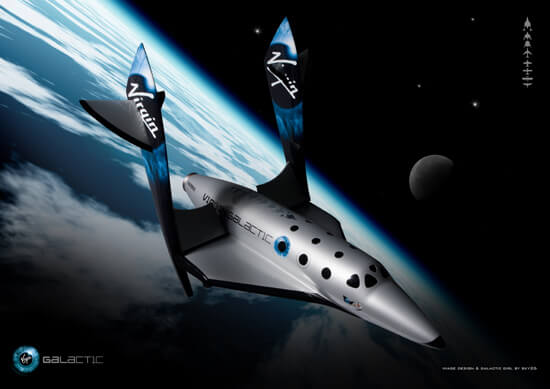
Above: SpaceShipTwo, in operation from 2011.
China's Three Gorges Dam is fully operational
Costing almost $30 billion, this is the largest power plant ever built. It has been in planning for nearly a century.
The dam body was completed in 2006 and the originally planned components of the project were finished in 2008. However, six additional generators are installed underground in 2011 - taking its total electric generating capacity to over 22 gigawatts.
The project management team and the Chinese state regard the project as a historic engineering, social and economic success: a breakthrough in the design of large turbines and a significant move toward the reduction of greenhouse gas emissions. It will remove some 100 million tonnes of CO2 and 2 million tonnes of SO2 that would otherwise have been generated by coal-fired power stations.
However, the dam has also flooded archaeological and cultural sites, displaced 1.25 million people, and is causing significant ecological changes, including an increased risk of landslides. The building of the dam has been a controversial topic, both in China and abroad.
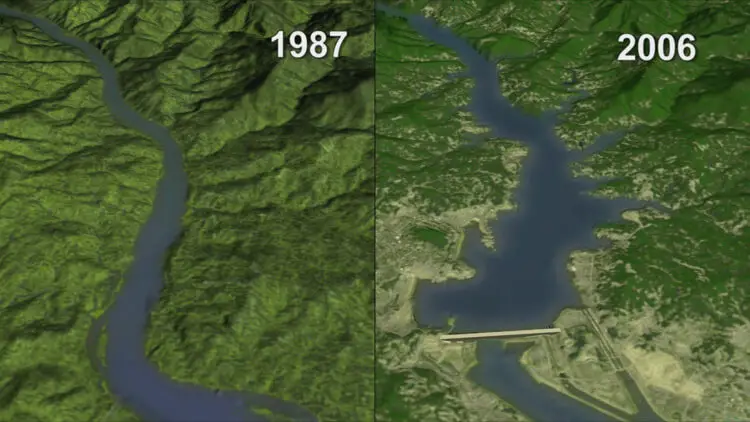
Economic growth remains sluggish in many markets
Although the worst of the economic downturn has passed by now, genuine growth and recovery remains sluggish - especially in countries like the UK, where the fall in private sector debt ratios and rebuilding of savings ratios lasts well into the second half of this decade. Grinding slow growth - as low as 1-1.5% in Europe, the US and Japan - persists for several years, which still feels like a recession to most of the public, and does little to improve levels of employment. Vast interest payments for Government debt force a reduction in social and defence spending and leads to higher taxes, which also harms growth. As if this wasn't bad enough, the baby boomers are now entering their retirement years. The younger generations are faced with a huge burden of debt.
With America nearly bankrupt, a clear shift in the balance of power is taking place from West to East. If the 19th century was Europe's century, and the 20th century was America's, then the 21st century looks like being Asia's - or at least, a combination of Asia's and America's.
London hosts the Olympic Games
London hosts the Olympic Games for the 3rd time in its history - the only city to have done so this many times. The two week event takes places amidst the largest security operation ever seen in peace-time Europe.
Aside from a small number of arrests, it passes without incident. Despite this, the media tries to hype the threat of a terrorist attack as much as possible during this time.
London has been transformed in recent years by a number of massive construction projects. In addition to the Olympic Games venues themselves, there is Stratford City - a new business district that will eventually rival the Square Mile and Canary Wharf. Then there is Crossrail - a £16bn rail connection linking Heathrow Airport with the central and eastern parts of the city. Various masterplans are helping to regenerate vast areas of land all over the city - including Greenwich Peninsula, Elephant & Castle, Croydon, Paddington, Battersea and elsewhere. These mixed-use developments contain hundreds of thousands of new homes, shops, and offices.
Several new landmarks dominate the skyline including the Shard of Glass at London Bridge, a 72-storey crystalline spire that redefines the capital's image.
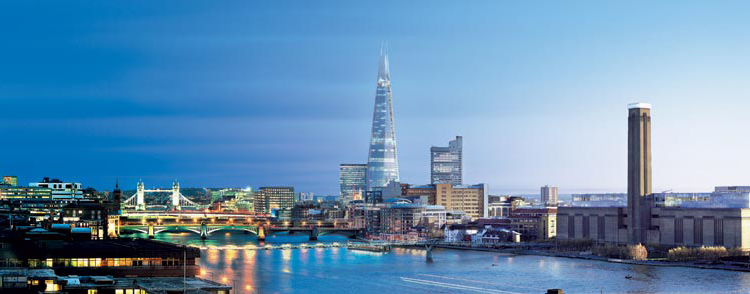
Credit: Hayes Davidson
Brain-computer interfaces allowing the paralysed to walk again
By this date, a prototype full-body exoskeleton has been devised which allows the paralysed to walk again - using their thoughts alone to control it.*
This is achieved using a neuroprosthetic device with a highly advanced brain-computer interface (BCI) at its core, driven by neurochips implanted in the patient's skull. These monitor electrical brain activity and adjust the movement of the limbs accordingly.
The project has been developed by an international team of neurophysiologists, computer scientists, engineers, roboticists, neurologists and neurosurgeons at laboratories around the world. Fresh hope is now being offered to millions of people affected by paralysis.*
A cure for baldness
Until now, more than half of men and a third of women have been affected by hair loss at some point in their lives. The $1bn hair loss industry has only provided treatments to save what they have left, or cover what they have lost - not to actually grow new hair.
Thanks to advances in stem cell research - along with a new compound - treatments are now available that can actually regenerate hair follicles.*
World's first 1-gigawatt offshore wind farm
Construction of the largest ever offshore wind farm is underway off the southeastern coast of England. Known as the "London Array", it will supply enough power for 750,000 homes - a quarter of all those in London.*
With a total of 341 turbines, it will reduce carbon emissions by nearly 2 million tonnes every year: a significant milestone in the government's plan to cut emissions by 80% by 2050.
This project marks the beginning of a major expansion of offshore wind power in Britain. Numerous other large-scale wind farms will be constructed in the coming decades - greatly reducing the country's dependence on foreign energy and creating thousands of new jobs in the green industry.
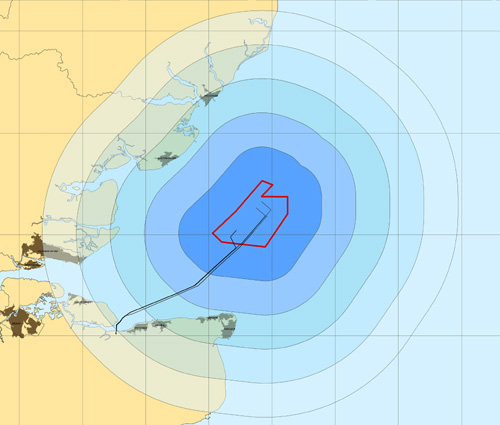
Mars Science Laboratory explores the Red Planet
This is by far the largest and most powerful rover ever sent to Mars. Among its many instruments is the first ever video camera taken to another planet, as well as the first 3D camera.
The mission has four goals:
- to determine if life ever arose on Mars
- to characterize the climate of Mars
- to characterize the geology of Mars
- to prepare for human exploration.
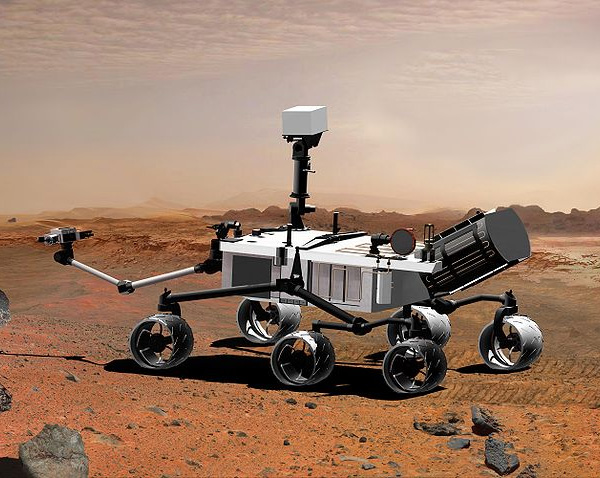
Barack Obama is re-elected
Obama now has a reduced majority, however. He is confronted with further economic difficulties, precipitated by an emerging energy crisis - the early effects of peak oil are being felt.

GNU Free Documentation License / Credit: Elizabeth Cromwell
Iran carries out its first nuclear test
After years of diplomatic stall tactics, Iran confirms its place in the "nuclear club" of countries.
Technology covertly supplied by Russia has allowed it to fulfill its nuclear ambitions. Faced with such a grave potential threat, Israel's economy goes into freefall.
Although the Iranian government repeatedly states its peaceful intentions, the region as a whole now enters a period of instability the likes of which has never been seen before. This nuclear test is viewed in the West as the most significant world event since 9/11.
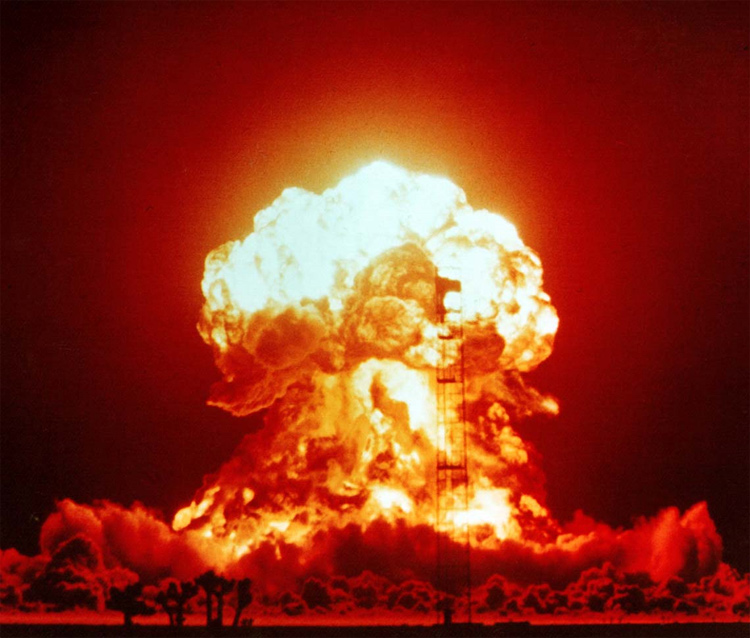
3D technologies are widespread
3D technology is now widespread across a range of communication and entertainment platforms.* It has become a mainstream element of cinema, TV, Internet, video games and even mobile. This technology dramatically enhances the immersion of users, providing them with a whole new level of interaction and realism.
James Cameron's Avatar, released in 2009, was a major breakthrough in terms of developing this format and raising awareness of its potential.
In 2010, new 3D TV channels are introduced and these can even be viewed without 3D glasses. This effect is achieved via multiple projectors behind the screen, combined with a lens array that creates a parallax effect from any direction. Among the many TV events during this time is the first ever FIFA World Cup to be screened in 3D.
Compatibility is soon incorporated into a range of consumer products including Blu-ray recorders, games consoles and personal computers.
By 2013, the technology has become widespread in homes in developed countries.*
India launches its second lunar exploration mission
Chandrayaan-2 becomes the second lunar probe to be sent by India's space agency. It includes an orbiter as well as two rovers: one lander/rover built by Russia, and a second smaller rover built by India. The wheeled rovers will move on the surface, picking up soil or rock samples for on-site chemical analysis. The data will be sent to Earth through the Chandrayaan-2 orbiter. The team is headed by Dr. Mylswamy Annadurai, who was behind the success of the previous mission (Chandrayaan-1).
James Webb telescope is launched
The long-awaited successor to the Hubble Space Telescope is launched. Its primary mirror has a collecting area six times larger than Hubble. The telescope is situated in an L2 orbit approximately 1.5 million kilometres from Earth.
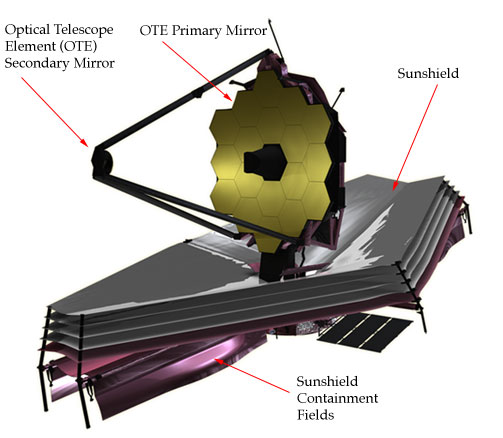
Personalised DNA sequencing for less than $100
DNA sequencing technology is now so fast and cheap that an entire human genome can be read in a matter of hours for less than $100, making it accessible to everyone. This has been made possible by a revolutionary new device called a nanofluidic chip.*
Medical treatments can now be delivered on a highly personalised level, uniquely tailored to a patient's genetic code. For example, a doctor can biopsy a cancer patient's tumor, sequence all of its DNA, and use that information to determine a prognosis and prescribe treatment - all for less than the cost of a chest X-ray. In the case of lung cancer, the doctor can determine the exact genetic changes in the tumor cells and order the chemotherapy best suited to that variant. Meanwhile, parents of newborns now have the option of determining if their baby is susceptible to conditions like diabetes, and then modifying the baby's diet and medication from day one to reduce the chance of it ever manifesting.
Internet "lifecasting" enters the mainstream
Digital devices are continuing to shrink in size, becoming ever more compact and miniaturised.* On-person webcams measuring less than a centimetre across are now being embedded in clothing, hats, spectacle frames and other discrete locations. This has led to the emergence of a new form of Internet blogging known as "lifecasting".
Rather than text updates, every moment of a person's daily experiences can now be captured on video, in real time. This is available on social networking sites, so that communities of users can "subscribe" to the lives of individuals they wish to follow. This includes a number of famous celebrities.
16 nanometer chips are in mass production
The successor to 22nm, this latest generation of chips continue the trend of Moore's Law, each containing more than 7.5 billion transistors. They will, in turn, be succeeded by 11nm chips - the ultimate limit of miniaturisation for traditional integrated circuits.
Robotic pack mules are entering military service*
Dynamically stable, quadruped robots are being deployed in military support roles now. These are accompanying soldiers in terrain too difficult for conventional vehicles. They use four legs for movement, allowing them to move across surfaces that would defeat wheels or treads. They are capable of running at 4 miles per hour (6.4 km/h), while carrying loads up to 340 pounds (150 kg) and climbing slopes with 35 degree inclines.*
Locomotion, navigation and balance are controlled by an onboard computer that receives input from the robot's many sensors, which include a stereo vision system, laser gyroscopes, joint position and ground contact monitors.
These machines greatly reduce the burden of equipment for soldiers.
MAVEN probe arrives at Mars
NASA's MAVEN probe arrives at Mars, to study its atmosphere and climate history.*
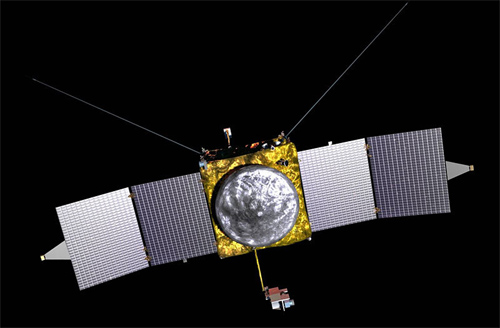
Most phone calls are made via the Internet now
The majority of homes and offices have now adopted Voice over Internet Protocol (VoIP) systems, such as Skype.* These connections are made over the Internet, rather than traditional phone lines.
Undoubtedly the biggest advantage of VoIP is the cost. PC-to-PC phone calls can be made anywhere in the world, at any time, for free. PC-to-phone connections usually charge a fee, but are generally much cheaper than standard phone services with conventional handsets.
Another advantage is the portability. Phone calls can be made and received from any PC - provided there is a broadband connection - simply by signing into your personal VoIP account.
Phone-to-phone VoIP is also portable. When you sign up with a VoIP servicer provider, the Internet phone or adaptor that is used with that service is assigned a unique number. This 'phone number' remains valid even if your VoIP service provider is located in England and you are connected to the Internet in Australia. An Internet phone is small and light enough to take with you anywhere. It can simply be plugged into any broadband connection, anywhere in the world, and used to make and receive calls, just as though you were in your own home or office.
There are several other features that make VoIP attractive. Call forwarding, call waiting, voicemail, caller ID and multiple-way calling are included with Internet telephone at no extra charge. Digital data such as pictures, documents and other files can also be transmitted at the same time you are talking on the phone.
Brazil hosts the FIFA World Cup
This is the second time the country has hosted the competition.
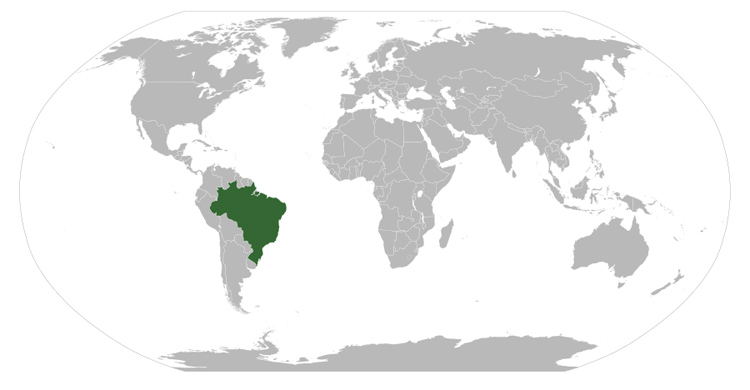
2015-2019
Virtual Reality makes a comeback
Enormous strides in computing power are making it possible to create exceedingly lifelike graphics, animations and 3D environments. At the same time, super-fast broadband is opening up new frontiers in cyberspace and enabling the development of "Web 3.0".
Combined with developments in on-person hardware, this is leading to the rebirth of virtual reality. Having been something of a gimmick in the 1990s, it is now becoming a serious tool for business, leisure, education and training. For the rich, options for this form of technology now include pod-like structures which are fully enclosing.*
Much of the content in these simulations is user-generated. There are many online communities for sharing and exchanging virtual objects, buildings, avatars, etc. The most impressive creations are rated and promoted in a manner similar to YouTube.
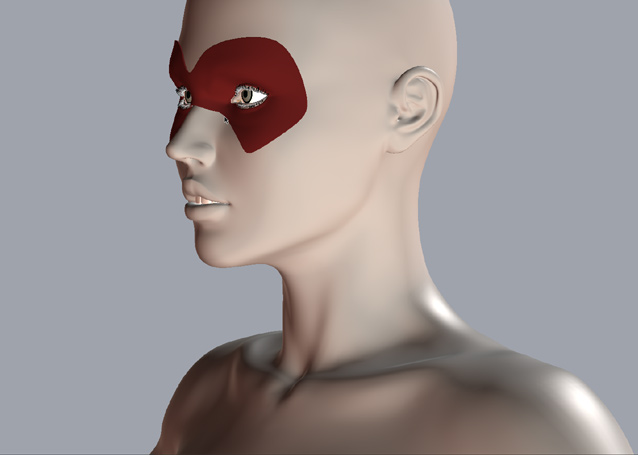
2015
Worldwide PC use reaches 2 billion
PC adoption in emerging markets has been growing at a phenomenal pace. There were a billion PCs in use in 2008, and this number doubles by 2015. In other words, it took nearly 30 years to reach the one billion mark, but only seven to grow from 1 billion to 2 billion.
Nanotech water filters are spreading to many developing countries
Third World countries are now benefitting from a revolutionary portable device. First revealed in 2007, it has become widespread by now.
The "Lifesaver Bottle" filters water-borne pathogens, using holes just 15 nanometers across, to prevent even the smallest viruses (25 nanometers across) getting through, and eliminating the need for chemicals to treat the water. The Lifesaver Bottle is fitted with a 4000UF replaceable purification cartridge that removes bacteria, viruses, cysts, parasites, fungi, and all other microbiological water-borne pathogens.*
It also comes with an activated carbon filter, made of a high specification activated carbon block. This reduces a broad spectrum of chemical residues including: pesticides, endocrine disrupting compounds, medical residues and heavy metals such as lead and copper. The carbon filter also eliminates bad tastes and odors from contaminates such as chlorine and sulphur. It is designed to last for approximately 250 litres.*
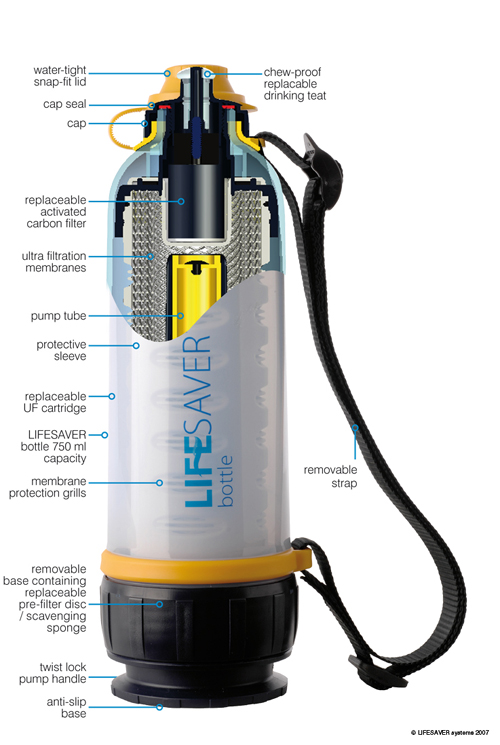
The first climate change refugees
As a direct result of sea level rises, the inhabitants of the Carteret Islands in Papua New Guinea have been forced to abandon their homelands.* Crops, trees and wells have been contaminated by seawater, while most of the buildings on the islands have been destroyed. Attempts to build sea wall defences were unsuccessful – these were simply washed away.*
The melting of polar ice sheets and glaciers, together with thermal expansion, could raise the level of Earth's oceans nearly 2m by 2100 - potentially displacing hundreds of millions of people.
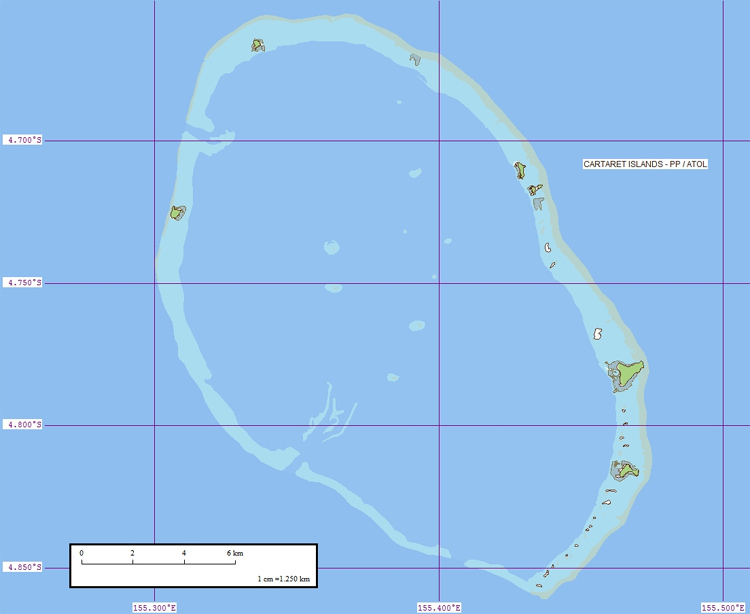
Credit: EVS-Islands
3D printing enters the consumer market
Until recently, this technology was extremely expensive - upwards of $15,000 per machine - and limited to use in industrial prototyping, product design, medical modeling and architectural models.* However, plummeting costs are now making it affordable to consumers.**
Rather than using ink on paper, these machines can actually "print" 3D objects. This is achieved by melting nylon powder and then shaping it based on computer instructions.
Countless different items can be produced – from jewellery and decorative giftware, to children's toys, kitchenware, replacement plugs, hooks, pipes, fittings, flooring and other household essentials.
Users can download new items and configurations from the Web.* Artists and hobbyists can even create their own, using these printers in combination with 3D scanners and modeling software.
In addition to falling costs, another reason that home 3D printing has taken off rapidly is that there is very little manufacturing being done in America and various other countries anymore. As a result, there is little or no pressure by manufacturing special interests against it.
In the decades ahead, this technology will evolve into nanofabricators, capable of reproducing items with atomic precision within minutes. It will ultimately lead to matter replicators with near-instantaneous production of virtually any object – including foodstuffs.
New Horizons probe arrives at Pluto
The probe was launched in 2006 and has travelled more than 4 billion kilometres through space. It returns the first close range, high resolution pictures of the icy world - along with its three moons - before passing through the Kuiper Belt. It will leave the solar system entirely in 2029.
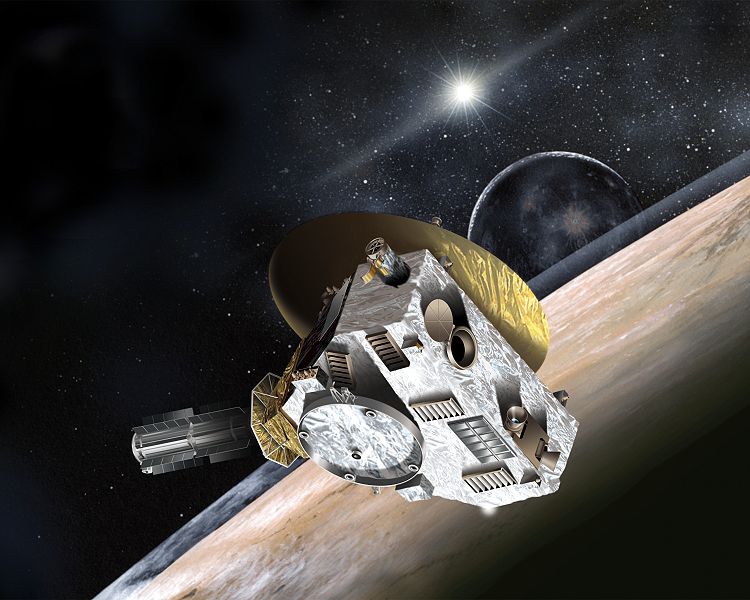
Dawn probe arrives at Ceres
Dawn is a robotic spacecraft sent by NASA on a mission to the asteroid belt. It reaches Vesta in 2011, before rendezvousing with the dwarf planet, Ceres, in 2015.
Ceres and Vesta are the two most massive members of the asteroid belt: 950 and 530 km in diameter, respectively. Dawn is the first probe to study and photograph them at close range. Both bodies formed very early in the history of the Solar System, thereby retaining a record of events and processes from the time of the formation of the terrestrial planets.
Dawn is also innovative - it becomes the first spacecraft to enter into orbit around a celestial body, study it, then re-embark under powered flight to a second target. All previous multi-target missions (such as the Voyager program) have involved rapid planetary flybys.*
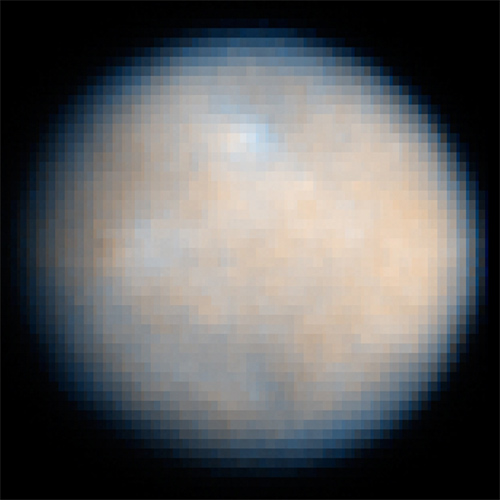
Credit: NASA
Voyager I enters the heliopause
Voyager I remains the most distant human-made object, traveling away from the Earth at a speed greater than any other space probe.
Launched in 1977, its original mission was to visit Jupiter and Saturn. It became the first probe to provide detailed images of these planets and their moons.
In 2003, it entered the "termination shock" - the point where solar wind particles slow down to subsonic speeds due to interactions with the local interstellar medium.
By 2015, it has travelled so far that it has begun entering a region known as the "heliopause" - the point where the interstellar medium and solar wind pressures balance. It remains operational during this time, pursuing its extended mission to study the very boundaries of the Solar System, including the Kuiper Belt and beyond.
The probe, along with its sister - Voyager II - will continue operating as they head for the "Bow Shock", the true beginnings of interstellar space. They will transmit signals back to Earth until at least 2025 (half a century after they were launched) before their power finally runs out.
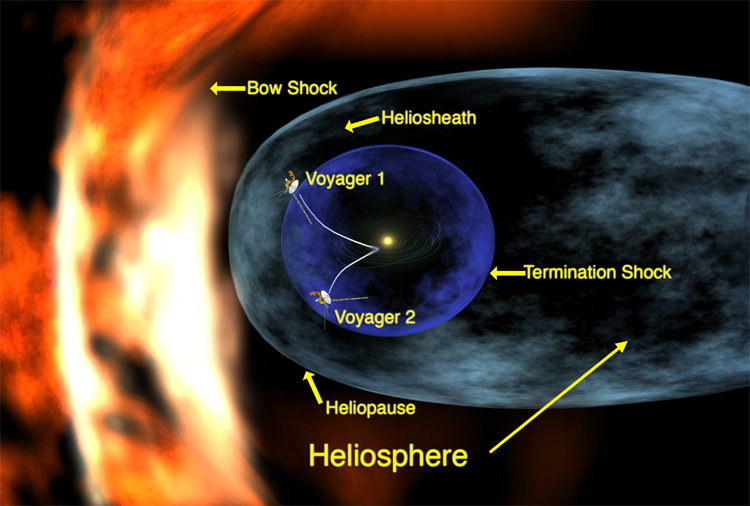
The US military withdraws from Afghanistan
The war had been going on since October 2001 - both as a response to the 9/11 attacks, and as a result of ongoing issues from before the attacks. The stated aim of the invasion was to find Osama bin Laden and other high-ranking Al-Qaeda members and to put them on trial, destroy the whole organisation of Al-Qaeda and remove the Taliban regime which supported them.
The Bush administration stated that, as policy, it would not distinguish between terrorist organisations and nations or governments that sheltered them. The United Nations did not authorise the US-led invasion of Afghanistan.
The first phase was the aftermath of the terrorist attacks of September 11, 2001, when the US launched Operation Enduring Freedom, to annihilate the safe haven to Al-Qaeda and its use of the Afghan territory as a base of operations for terrorist activities. In that first phase, US and coalition forces, working with the Afghan opposition forces of the Northern Alliance, quickly ousted the Taliban regime. During the following Karzai administration, the character of the war shifted to an effort aimed at smothering insurgency.
Over the following years, however, it became clear that little progress was being made in the hunt for bin Laden - and planning to ensure the long-term political, social and economic stability of the country was lacking. America's presence in Afghanistan was inflaming tensions along Pakistan's border. In the eyes of many people, the invasion was doing more to destabilise the country than protect it. By 2009, more than 1,500 coalition troops had been killed, while even the most conservative estimates put civilian deaths in the tens of thousands. There were also multiple accounts of torture and human rights violations by coalition forces.
In addition, the cost of the war was mounting and had now reached almost $7bn per month, at a time when America was facing its worst financial crisis in decades.
Public opinion - having initially been high - declined substantially. When President Obama announced a further increase of 30,000 US troops, cities across America saw protests. Although this troop surge met with some success, it became clear that the war was simply unsustainable. Efforts by the US to train the Afghan National Army and to transfer security responsibility were plagued by inefficiency, widespread illiteracy and endemic corruption.
A series of phased withdrawals began in 2011, with the last remaining US troops pulling out in 2016 - fifteen years after the start of the invasion.* This made it almost as long as the Vietnam War.

Credit: Youngottoman
US vehicles are becoming more fuel-efficient
New standards enacted by the Obama administration have boosted the fuel efficiency of light duty vehicles (cars, crossovers, SUVs, vans and pickup trucks) to an average of 34 miles per gallon (MPG).*
This will reduce CO2 emissions by almost 1 billion metric tons and conserve 1.8 billion barrels of oil. In addition, the average buyer is saving around $3,000 over the lifetime of the vehicle - even after the higher initial purchase costs are taken into account.
These efficiency gains have come from smaller, more efficient engines with direct injection and/or turbochargers; more sophisticated automatic and dual-clutch transmissions (DCTs); hybrid-electric systems; clean diesel engines; tires with lower rolling resistance; more aerodynamic vehicles and lighter-weight materials.
The US still lags behind the rest of the world, however. New vehicles in Europe and Japan, for instance, are reaching 50 MPG on average.
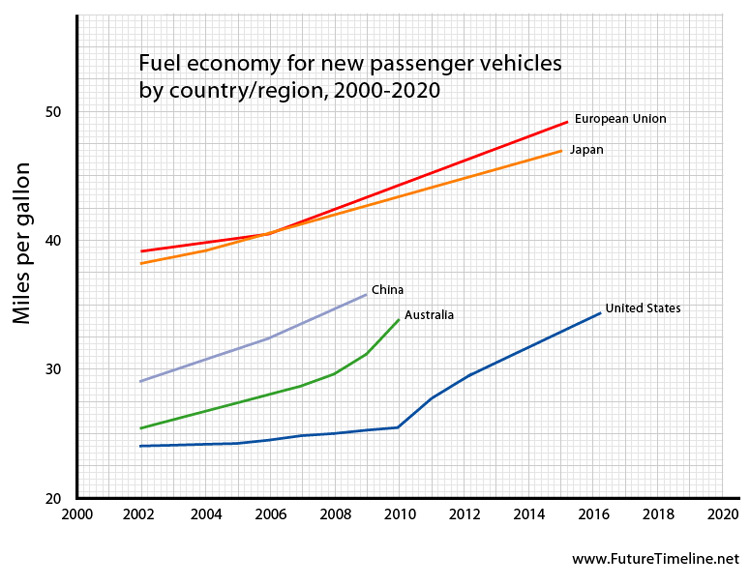
Holographic Versatile Disc (HVD) replaces Blu-Ray
These ultra-high density discs are capable of holding 1Tb of data - equivalent to over 200 DVDs. They work by analysing micro-holograms in 3D, rather than just markings on the surface. This allows data to be far more densely packed than conventional optical technology.
The price of storage per gigabyte is plummeting - from around $1 per gigabyte in 2006, to less than 10 cents now. This is an example of the trend of exponential progress (rather than linear) seen in forms of information technology.
HVD itself is in danger of becoming obsolete, before it has even been properly established, as solid state flash drives are increasingly being used for digital transfer, some with even higher capacities, along with read and write speeds faster than any optical disc. The new SDXC card format specification for example has already reached the 2TB mark.
Bio-cameras matching human eye resolution
Advances in biotech and sensor technology have enabled the development of tiny "bio-cameras".* These devices can be implanted like contact lenses, and are capable of taking photos with hundreds of millions of pixels' worth of information: equal to the resolution of the human eye itself.*
For now, they are a luxury item used only by the rich - or in specialist roles such as covert spying operations. However, within a few years they will begin entering mainstream use. Future versions will enable the capture of moving video and audio, in addition to static photos.
Rio de Janeiro hosts the Olympic Games
Rio becomes the first ever South American city to host the event.

Credit: Miika Mattila
Total solar eclipse in the USA
On August 21st of this year, a total eclipse occurs in the United States - the first visible from the US since 1991 (just from part of Hawaii), and the first visible from the contiguous US since 1979.
Totality occurs along a path curving from Oregon to South Carolina, and lasts for roughly 2 minutes and 40 seconds. The location and time of "greatest eclipse" is on the western edge of Christian County, Kentucky at 36.97 degrees North and 87.65 degrees West, occurring at 18:25 UTC.
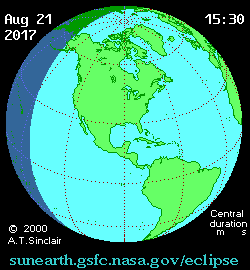
Credit: NASA
Crossrail opens in London
One of Europe’s largest ever transport projects, Crossrail expands London’s tube network capacity by over 10% and brings enormous regenerative benefits to the city. Costing over £16bn, the line is 120km in length (including 42km of tunnels). It runs from Berkshire in the west to Essex in the east, linking together all of the main economic hubs in the capital - Heathrow Airport, the West End, the City of London and Canary Wharf.
Ten-coach trains, roughly 200 metres long, run at frequencies of up to 24 trains per hour in each direction during the peak periods.
Electronic paper is widespread
This technology has been in development for over a decade* and is now in widespread use.
Organic thin film transistors (TFT) are combined with organic, electroluminescent displays. This produces flexible, paper-thin devices less than 0.3mm in thickness and capable of running high-quality video. The applications are endless. They include true "e-books" and "e-papers" (which can also be read in the dark), clothes and other textiles with electronic displays, video posters, video leaflets, video cards, road signs that are self-illuminating, video instructions on food packaging and other boxed items.
Further development leads to much greater contrast ratio - resembling printed paper more than a screen (the latter is often hard to see in direct sunlight and other conditions).
This technology also marks a step towards the first paperless offices, which in turn helps to reduce deforestation.
Portable medical lasers that seal wounds
Star Trek-style devices shaped like pens are now available which can seal wounds, using specially controlled lasers in combination with a blood protein called albumin. Heated at just the right temperature, this forms a natural "glue" after the skin has cooled down. Using this method allows a wound to be stronger, water-tight, and less likely to scar than traditional stitches.
Following several years of development and refinement, they are used in many hospitals now.* These devices will be cheap and safe enough for the consumer market within a few years.
Teleportation of simple molecules
For a number of years, scientists had been teleporting individual atoms and particles of light. By this date, the first molecules such as water and carbon dioxide are being teleported.* This will be followed in the late 2030s by complex organic molecules such as DNA and proteins.*
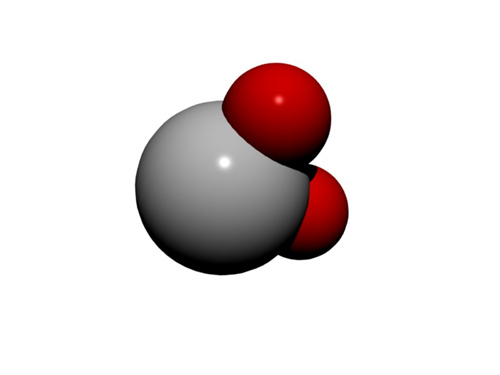
The ITER experimental fusion reactor is switched on
Human-engineered fusion has already been demonstrated on a small scale. The problem has been finding ways of scaling it up to commercial levels in an efficient, economical, and environmentally benign way.
ITER - previously known as the International Thermonuclear Experimental Reactor - aims to be the first project to achieve this. Built in southern France at a cost of €20 billion, it has taken over a decade to construct and is one of the largest scientific projects ever undertaken, second only to the International Space Station. This joint research experiment is funded by the US, EU, Japan, Russia, China, India and South Korea.
To demonstrate net fusion power on a large scale, the reactor must simulate the conditions at the heart of the Sun. For this, it uses a magnetic confinement device called a tokamak. This doughnut-shaped vacuum chamber generates a powerful magnetic field that prevents heat from touching the reactor's walls. Tiny quantities of fuel are injected into and trapped within the chamber. Here they are heated to 100 million degrees, forming a plasma. At such high temperatures, the light atomic nuclei of hydrogen become fused together, creating heavier forms of hydrogen such as deuterium and tritium. This releases neutrons and a huge amount of energy.
Following its operational activation in 2018, it is hoped that ITER will eventually produce more than 500 megawatts of power, in bursts of 400 seconds or more. This compares with 16 MW for the Joint European Torus (JET) in 1997, the previous world record peak fusion power, which lasted only a few seconds.
ITER will require another few decades before its reactor has been sufficiently perfected. To generate the sort of continuous levels of power required for commercial operation, it will need a way of holding the plasma in place at the critical densities and temperatures. This will need refinements in the design of the chamber, such as better superconducting magnets and advances in vacuum systems.
However, it could ultimately lead to a revolution in energy. If this project were to succeed, humanity would gain a virtually unlimited supply of clean, green electricity.*
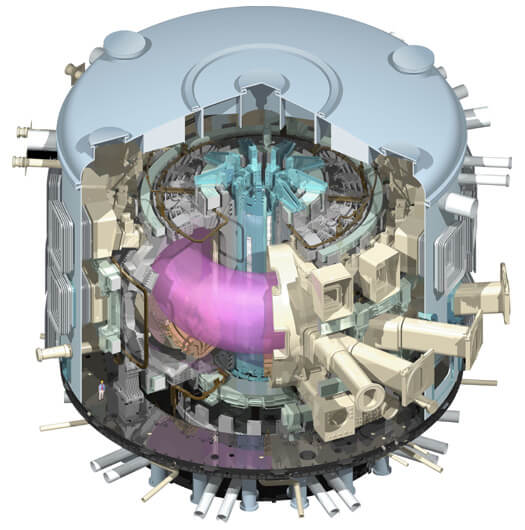
Source: ITER
The European Extremely Large Telescope is operational
This revolutionary new ground-based telescope has the aim of observing the Universe in greater detail than even the Hubble Space Telescope. A mirror of approximately 42 metres (138 ft) will allow the study of the atmospheres of extrasolar planets. It will also perform "stellar archaeology" - measuring the properties of the first stars and galaxies, as well as probing the nature of dark matter and dark energy.
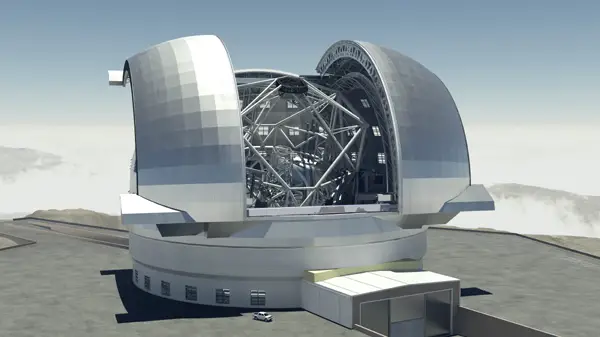
Credit: ESO
Ubiquitous internet nodes connect appliances, vehicles, etc.
In developed nations, many of the day-to-day routines in the home are becoming automated. Fridges, for instance, can be programmed to order new food before they become empty.* RFID microchips - smaller than grains of sand - are printed on packaging labels. These connect wirelessly to the refrigerator, which sends an order via the Internet. New food is then delivered to the customer's door at a pre-arranged time.
Meanwhile, boilers and other appliances can notify an engineer when they break down, while heat and lighting systems can be activated in real time as a person is on their way home from work (rather than being programmed for a fixed time).
Devices are also being synchronised in various ways. They can even sense where you are in the home. A person can be listening to a football commentary in their bedroom, for example, then walk to the lounge and have the television activate itself, then walk to their car outside and have the signal "follow" them by turning on the appropriate radio channel. In addition to being linked with their user's home network, the majority of cars and other vehicles now have Internet access.
Robot insect spies are in military use
These "micro aerial vehicles" - no larger than a common house fly - have been in development for over a decade.* One of the major hurdles was creating sufficient battery power in such a small object, as well as keeping them light enough to remain airborne. Advances in nanotechnology solved this problem. Together with improvements in computing power, this allowed circuitry and components to be packed more closely.
The robots are being used primarily in spying missions, where they quite literally serve as a "fly on the wall" - recording and transmitting audio-visual information. An individual robot is equipped with miniature cameras, microphones, modem and GPS. Many terrorist cells are being infiltrated thanks to this.
More sophisticated versions are being developed for assassin roles. These have capsules in the abdomen of the insect, filled with cyanide or another lethal toxin. This is delivered to the target via a small needle capable of piercing human skin.
Some robots work in groups, forming networks that combine their abilities. Over the next few decades, further advances in nanotech will lead to enormous swarms of these machines being deployed on the battlefield.*
However, concerns are being raised as to how this technology will affect the privacy and safety of citizens.
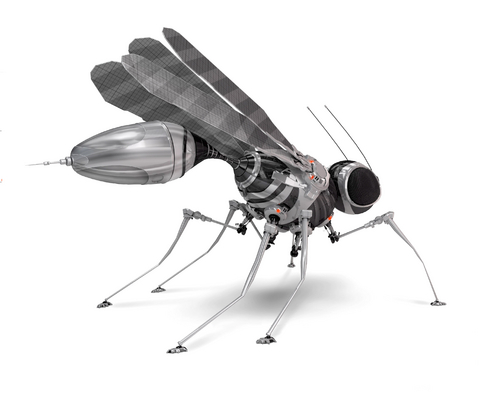
© Aleksandr Atkishkin | Dreamstime.com
Consumer devices with 100 Gbit/s transfer speeds
A new form of data transfer is now available for the consumer market. This is known as "Light Peak" and is replacing the Universal Serial Bus (USB) connections which have been the standard for many years.
The USB 3.0 specification allowed transfer speeds of 4.8 Gbit/s. An early version of Light Peak achieved 10 Gbit/s. This latest version, however, can achieve nearly 100 Gbit/s - enough to transfer a full-length Blu-Ray movie in around two seconds.
The optical technology of Light Peak also allows for smaller connectors with longer, thinner and more flexible cables. In addition, it can run multiple protocols simultaneously over a single cable, enabling the technology to connect devices such as peripherals, workstations, displays, disk drives, docking stations and more.*
Anti-fat drug is available
A drug that lets you eat whatever you want without gaining weight is now available.* There is enormous demand for this product, which leads to a major drop in obesity levels throughout the developed world - especially in countries like the USA, which until now had been experiencing a crisis in this regard. Average life expectancy is increased as a result, since there are less people dying of heart-related illnesses.
The new World Trade Center is complete
A full 17 years after the destruction of the World Trade Center, its replacement - 1 World Trade Center - is finally complete. Formerly known as the Freedom Tower, the project was delayed due to acrimonious disputes over money, security and design.*
The new tower features a spire, reaching a total height of 1,776 ft (a reference to the year that America declared its independence). The roof height is identical to that of the previous twin towers on the site.* The project also features a memorial to the victims of the 9/11 attacks.
Computers break the exaflop barrier
An exaflop is 1,000,000,000,000,000,000 (a million trillion, or a quintillion) calculations per second. The world's top supercomputers are now achieving this speed. This represents a thousandfold improvement over machines of a decade earlier.*
This exponential growth will continue, so that by 2029, computers will surpass the zettaflop barrier - a thousand times faster than an exaflop computer of 2019, and a million times faster than a petaflop computer of 2009. One of the many resulting applications will be the accurate simulation of an entire human brain and its neurons in real time.
Personal computers in 2019 are becoming ever smaller, lighter and more compact - with laptops, netbooks and other mobile devices far outnumbering desktops.* Physical hard drives are becoming almost redundant, with most storage now done online using "virtual drives" housed in remote servers, aided by the tremendous growth in broadband speeds and 5G wireless communications.
Web applications have reached startling levels of power and sophistication, especially where search engines are concerned. These not only find keywords in a search, but also interpret the context of the request - and most use voice recognition software. Users can ask their computer a highly specific question (such as "I'd like to see a comedy at the cinema after 9pm, then have an Italian meal for less than $20") and receive detailed answers and recommendations, often customised to their exact personal tastes and interests.
This emerging form of AI - which effectively acts like a personal assistant - means the web now offers a far more productive and intuitive experience.*
Bionic eyes are commercially available
Following trials, the world's first bionic eyes are now available for persons with degenerative vision loss.
These devices use miniature cameras, mounted on a pair of glasses. The cameras beam visual information into an electrode array which is connected to neurons in the retina. Electrical impulses are then transmitted through the optic nerve to the vision centres of the brain.
The first prototype of this technology was somewhat crude and pixelated, with only 100 dots of resolution. However, this new version provides 1000 dots, allowing the patient to recognise faces and read large print.*
Bionic eyes continue to gain in sophistication over the following decades, making exponential progress in resolution and visual quality. Fully artificial eyes eventually become available that can actually provide better vision than normal eyes - leading even healthy people to "upgrade" their sight.
Automated freight transport
Autonomous rapid transit systems have already been in place at certain airports, and on the metro systems of cities. By this date, significant numbers of driverless trucks have begun appearing on the roads.* They are capable of travelling hundreds of miles by themselves, negotiating traffic and other obstacles, and utilising advanced GPS technologies. They have a number of advantages over human drivers - such as being able to run 24 hours a day without getting tired, never being absent, and not requiring a salary or training. The trucks can also detect mechanical or software faults.*
These automated vehicles will eventually include cars, taxis and other types of road vehicles, becoming widespread by the 2030s.
The Aral Sea disappears from the map
As recently as the 1970s, the Aral Sea was the world's fourth largest lake, with an area of 68,000 km2.
However, Soviet irrigation projects diverted the Amu Darya and Syr Darya rivers which fed into it. By 2004, the sea had shrunk to 25% of its original surface area, and a nearly fivefold increase in salinity had killed most of its natural flora and fauna. By 2007, it had declined to 10% of its original size, splitting into three separate lakes, two of which were too salty to support fish. The once prosperous fishing industry had been virtually destroyed, and former fishing towns along the original shores became ship graveyards.
The Aral Sea was also heavily polluted, largely as a result of weapons testing, industrial projects, pesticides and fertilizer runoff. Wind-blown salt from the dried seabed damaged crops and polluted drinking water, while salt- and dust-laden air causd major public health problems in the Aral Sea region. The retreat of the sea also caused localised climate change, with summers becoming hotter and drier, and winters colder and longer.
Although a dam project in 2005 saved what little remained of the northern part of the sea (the Small Aral), the much larger southern part of the sea (the Large Aral) continued to shrink, and by 2019 had evaporated entirely.*
Global oil demand exceeds 100m barrels per day
Meanwhile, new discoveries are continuing to show an alarming decline. As the decade draws to a close, it becomes painfully obvious to all that "peak oil" has been reached. And with 60% of all recoverable oil in the Middle East, conflict looms for much of the region.*
References
1 Big Quake "Guaranteed" to Hit California by 2037, National Geographic:
http://news.nationalgeographic.com/news/2008/04/080414-AP-earthquake.html
Accessed 28th August 2009.
2 First Self-Replicating Synthetic Bacterial Cell, J Craig Venter Institute:
http://www.jcvi.org/cms/research/projects/first-self-replicating-synthetic-bacterial-cell/overview/
Accessed 23rd May 2010.
3 Neda Agha-Soltan, YouTube:
http://www.youtube.com/watch?v=mVR2rLLqYJw
Accessed 31st December 2009.
4 How long can the Iranian government last?, FT.com:
http://blogs.ft.com/rachmanblog/2009/12/how-long-can-the-iranian-government-last/
Accessed 31st December 2009.
5 Global oil-price roller coaster challenges the world, Tehran Times:
http://www.tehrantimes.com/index_View.asp?code=185893
Accessed 31st Dec 2008.
6 U.S. Solar Market to Double in the Next Year - Government incentives and lower solar prices are starting to pay off, Technology Review:
http://www.technologyreview.com/energy/24498/
Accessed 11th February 2010.
7 FDA Advisory Panel Recommends Approval of VisionCare's Implantable Telescope for End-Stage Macular Degeneration, VisionCare:
http://www.visioncareinc.net/2009_03_30.html
Accessed 18th April 2009.
8 Researchers enable a robot to fold towels, University of California, Berkeley:
http://www.berkeley.edu/news/media/releases/2010/04/02_robot%20.shtml
Accessed 13th April 2010.
9 World's Most Powerful Supercomputer Coming to Iowa, Fox News:
http://www.foxnews.com/scitech/2010/04/28/supercomputer-iowa-ncsa-ibm-bluewater/
Accessed 3rd May 2010.
10 Military Supercomputer Sets Record, The New York Times:
http://www.nytimes.com/2008/06/09/technology/09petaflops.html
Accessed 3rd May 2010.
11 Robot Wars: The Rise of Artificial Intelligence, The Independent:
http://www.independent.co.uk/news/science/robot-wars-the-rise-of-artificial-intelligence-1203693.html
Accessed 29th Dec 2008.
12 "Their goal is to enable a paralyzed person to walk again by the end of 2012."
Brain-Machine Interface Offers Hope to the Paralyzed, Institute of Electrical and Electronics Engineers:
http://www.ieee.org/portal/site/tionline/menuitem.130a3558587d56e8fb2275875bac26c8/index.jsp?&pName=institute_level1_article&TheCat=2201&article=tionline/legacy/inst2009/oct09/featuretechnology.xml&
Accessed 15th November 2009.
13 The Walk Again Project:
http://www.walkagainproject.org/
Accessed 15th November 2009.
14 Possible cure for baldness, YouTube:
http://www.youtube.com/watch?v=V64ht1r8APo
Accessed 5th January 2010.
15 World's largest offshore wind farm to be built off Kent coast, DailyMail.co.uk:
http://www.dailymail.co.uk/news/article-1180819/Worlds-largest-offshore-wind-farm-built-Kent-coast.html
Accessed 12th May 2009.
16 Cinema leads the way in opening up 3D - but TV, games and mobile are not far behind, FoxMedia.co.uk:
http://www.foxmedia.co.uk/intnws5.htm
Accessed 20th December 2009.
17 $100 Genome, Technology Review:
http://www.technologyreview.com/read_article.aspx?ch=specialsections&sc=tr10&id=22112
Accessed 19th April 2009.
18 Compact camcorders for adrenaline junkies, BBC:
http://news.bbc.co.uk/1/hi/programmes/click_online/8599397.stm
Accessed 5th April 2010.
19 2014 seems the most likely date, based on this article from 2006:
Robotic dog of war, CNN:
http://edition.cnn.com/2006/TECH/03/08/army.robot.dog/
"The more powerful, autonomous BigDog will be ready for battle within the next eight years."
Accessed 8th December 2009.
20 BigDog - The Most Advanced Rough-Terrain Robot on Earth, Boston Dynamics:
http://www.bostondynamics.com/robot_bigdog.html
Accessed 5th April 2010.
21 MAVEN (spacecraft), Wikipedia:
http://en.wikipedia.org/wiki/MAVEN_%28spacecraft%29
Accessed 24th April 2010.
22 Jacqui Smith's secret plan to carry on snooping, The Times:
http://www.timesonline.co.uk/tol/news/politics/article6211101.ece?token=null&offset=0&page=1
Accessed 4th May 2009.
23 NAU, an international design collective, is developing a prototype of the "Immersive Cocoon". This pod-like structure fully encloses a person, allowing graphics to be displayed around them in a 3-D environment, with 360° screens and full surround sound. NAU completes its prototype in 2009, and models are going to be commercially available by 2014. See Designers developing virtual-reality 'Cocoon', CNN.com: http://edition.cnn.com/2008/TECH/09/11/immersive.cocoon/index.html
Accessed 13th Sept 2008.
24 Michael Pritchard makes filthy water drinkable, TEDTalks:
http://www.youtube.com/watch?v=rXepkIWPhFQ
Accessed 23rd September 2009.
25 Carteret Islands: 'The sea is killing our island paradise', The Telegraph:
http://www.telegraph.co.uk/earth/carteret-islands/6771651/The-sea-is-killing-our-island-paradise.html
Accessed 11th December 2009.
26 Dimension uPrint Personal 3D Printers, Stratasys, Inc.:
http://www.dimensionprinting.com/3d-printers/3d-printing-uprint.aspx
Accessed 17th May 2010.
27 3D Printers Drop in Price, Almost Ready to Invade Your Home, Gizmodo:
http://gizmodo.com/gadgets/printers-get-interesting/3d-printers-drop-in-price-almost-ready-to-invade-your-home-258582.php
Accessed 17th May 2010.
28 Emerging trends: 3D printing; robots galore; human augmentation, ZDNet:
http://www.zdnet.com/blog/btl/emerging-trends-3d-printing-robots-galore-human-augmentation/6574?tag=untagged
Accessed 17th May 2010.
29 Shapeways:
http://www.shapeways.com/
Accessed 17th May 2010.
30 Dawn - Journey to the Asteroid Belt, NASA:
http://www.nasa.gov/mission_pages/dawn/main/index.html
Accessed 19th April 2010.
31 U.S. will be out of Afghanistan by 2017: White House, Reuters:
http://www.reuters.com/article/idUSTRE5AM3E520091125
Accessed 31st December 2009.
32 Obama and EPA Launch 34.1-MPG Fuel-Economy Rules for 2016, Green Car Reports:
http://www.greencarreports.com/blog/1043951_obama-and-epa-launch-34-1-mpg-fuel-economy-rules-for-2016
Accessed 8th April 2010.
33 Human brain: fuse with computer chips biodigital brain, YouTube.com:
http://www.youtube.com/watch?v=9tIIbDunFNs
Accessed 2nd May 2009.
34 Notes on the Resolution and Other Details of the Human Eye, ClarkVision.com:
http://clarkvision.com/imagedetail/eye-resolution.html
Accessed 2nd May 2009.
35 Razor-thin TV you can wear as a T-shirt, Daily Mail:
http://www.dailymail.co.uk/sciencetech/article-457670/Razor-TV-screen-wear-T-shirt.html
Accessed 31st Dec 2008.
36 Sci-fi laser stiches wounds, Reuters.com:
http://www.reuters.com/news/video?videoId=98448&videoChannel=6&rpc=64&refresh=true
Accessed 16th May 2009.
37 Michio Kaku on Teleportation, YouTube:
http://www.youtube.com/watch?v=-FqLCLooayM
Accessed 3rd December 2009.
38 Steven Cowley: Fusion is energy's future, TED Talks:
http://www.youtube.com/watch?v=S6BLFdBfgfU
Accessed 23rd December 2009.
39 v-Fluence CEO Contends Growth in Mobile “Apps” Forebodes PC’s Demise, openpr.com:
http://www.openpr.com/news/78105/v-Fluence-CEO-Contends-Growth-in-Mobile-Apps-Forebodes-PC-s-Demise.html
Accessed 13th May 2009.
40 A Hornet-sized Robotic Insect Can Now Fly, Singularity2050.com:
http://www.singularity2050.com/2007/07/a-hornet-sized-.html
Accessed 26th September 2009.
41 See 2042.
42 Light Peak Technology, Intel:
http://techresearch.intel.com/articles/None/1813.htm
Accessed 15th November 2009.
43 The Future Is Now? Pretty Soon, at Least, nytimes.com:
http://www.nytimes.com/2008/06/03/science/03tier.html?_r=1
Accessed 13th May 2009.
44 Secret report: Ground Zero Freedom Tower construction lags, slated for 2018 finish, New York Daily News:
http://www.nydailynews.com/ny_local/2009/08/04/2009-08-04_touted_ground_zero_construction_projects_years_off_schedule__report_behind_the_t.html
Accessed 11th October 2009.
45 Skyscraper diagrams, SkyscraperPage.com:
http://skyscraperpage.com/diagrams/?searchID=45491917
Accessed 9th January 2010.
46 IBM breaks petaflop barrier, infoworld.com:
http://www.infoworld.com/t/networking/ibm-breaks-petaflop-barrier-263
Accessed 13th May 2009.
47 How Web 3.0 Will Work, HowStuffWorks.com:
http://computer.howstuffworks.com/web-302.htm
Accessed 13th May 2009.
48 Trial of bionic eye within three years, ABC South West Victoria:
http://www.abc.net.au/news/stories/2010/03/30/2860256.htm?site=southwestvic
Accessed 18th April 2010.
49 The robot revolution: Driverless trucks and voice-activated pets could be commonplace by 2019, DailyMail.co.uk:
http://www.dailymail.co.uk/sciencetech/article-1207784/The-robot-revolution-Driverless-trucks-voice-activated-pets-commonplace-2019.html
Accessed 20th August 2009.
50 Aral Sea, Kazakhstan, nasa.gov:
http://eol.jsc.nasa.gov/sseop/EFS/photoinfo.pl?PHOTO=STS085-503-119
Accessed 1st June 2009.
51 Peak Oil: Life After the Oil Crash, lifeaftertheoilcrash.net:
http://www.lifeaftertheoilcrash.net/
Accessed 13th May 2009.

No comments:
Post a Comment